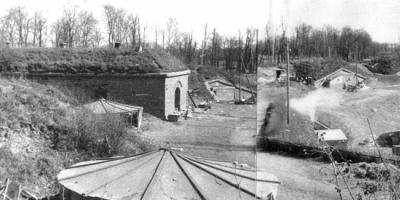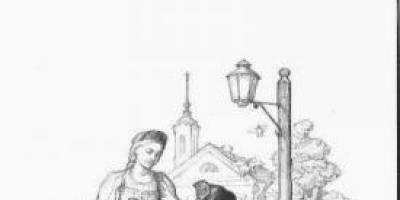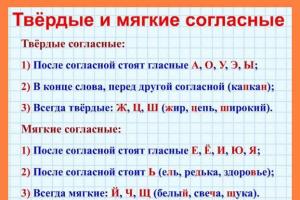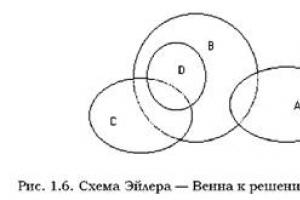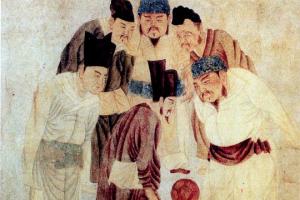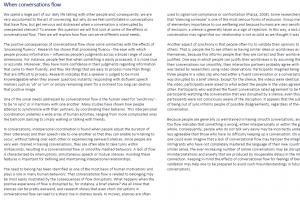Tsar and Grand Duke, son of Tsar Alexei Mikhailovich and his wife Maria Ilyinichna, from the Miloslavsky family, b. August 27, 1666, died January 29, 1696. Since childhood, Ivan Alekseevich was distinguished by extreme illness, like his three older brothers; he suffered from scurvy, had poor eyesight, and throughout his life remained a weak, underdeveloped person, incapable of any activity. After the death of Tsar Feodor Alekseevich on April 27, 1682, the Naryshkin party (princes Dolgoruky and Golitsyn), fearing the return to power of the Miloslavskys, took advantage of the sickness and weakness of the legal heir, 16-year-old John, and proclaimed 10-year-old Peter tsar. When Patriarch Joachim and the boyars asked the people gathered in the square a question: who should be king? - exclamations of “Peter Alekseevich” drowned out the voices of the few who stood for John. This is what trustworthy contemporaries say; an official document dated May 26, 1682 says that Ivan Alekseevich himself declared at the council that it was more fitting for Peter to be on the throne, since his mother, Tsarina Natalya Kirilovna, was alive, and “surrendered the kingdom” to his brother; but there can hardly be any doubt that the official story is not entirely accurate and that simply in the official document it was considered necessary to present John’s renunciation of rights to the throne as voluntary; There is also news that Tsar Feodor Alekseevich himself, before his death, wanted to declare Peter heir to the throne. - Princess Sophia and the Miloslavskys, her and John’s closest relatives, soon restored the archers against the Naryshkins and their supporters who became the head of the administration; On May 15, 1682, the archers were indignant and rushed to the Kremlin Palace, influenced by rumors that the Naryshkins had strangled Tsarevich John. John, together with Peter, went out onto the porch of the palace to the crowd of archers, and said that no one was harassing him and that he could not complain about anyone; the excitement began to subside, but the efforts of agents Miloslavsky and Sophia on the one hand and the unreasonable act of the prince. Yu. Dolgoruky, on the other hand, gave rise to the sad scenes of the Streltsy revolt. On May 23, after the defeat of the Naryshkin party, the archers demanded the accession of John. A council of the clergy and all officials of Moscow had to agree to the demand of the triumphant party, and John was proclaimed king along with Peter. On May 26, at the new demand of the archers, inspired by Princess Sophia, the Duma formally declared John the first, and Peter the second king; a month later, on June 25, John and Peter were solemnly crowned kings. - However, at court and after the accession of Ivan Alekseevich, there remained persons directly hostile to him: in 1684. several boyars dared to disobey the order “to follow the holy icons with Tsar Ivan Alekseevich,” for which they were disgraced; under the banner of protecting the weak John, Princess Sophia fought against Peter’s party; but John himself did not take any part in this struggle. In 1689, Fyodor Shaklovity unsuccessfully tried to outrage the Streltsy regiments with rumors that Lev Naryshkin broke the royal crown, threw logs at John’s room, and once broke into the doors of his chambers with some evil intent. On the day of Sophia’s final break with Peter, September 1, 1689, Tsar John treated Sophia’s supporters, serving foreigners and courtiers with wine and vodka from his own hands, but then, when Peter demanded the extradition of Shaklovity, John announced to Colonel Sergeev sent from Peter that he he will order Shaklovity to be extradited if his uncle, Prince Peter Prozorovsky, comes for him, and ordered to tell Sophia that he will not quarrel with his brother in anything for her princess, not only for Shaklovity. After the fall of Sophia, John met Peter in Moscow “with utmost brotherly love.” John Alekseevich did not interfere with the affairs of government, and “was in unceasing prayer and firm fasting.” Despite his illnesses, he rarely missed church services, went on pilgrimages to monasteries and especially often visited the Novodevichy Convent, and stayed there for a long time; Peter, from one of his business trips, writes to his brother about the veneration of the relics of miracle workers according to his vow; John, having received the news of Peter’s capture of two towers near Azov, in a reply letter, rejoices mainly in the fight “against the enemies of God and Christian” and asks his brother to take care of himself in battles. - On January 9, 1684, Ivan Alekseevich married Praskovya Fedorovna from the Saltykov family, chosen for him by Princess Sophia, and had from her daughters Maria (born March 21, 1689), Feodosia (born June 4, 1690), Catherine (born October 29, 1691), Anna (later Empress, born January 28, 1693, died October 17, 1740) and Praskovya (born May 12, 1694). The disease, meanwhile, quickly destroyed his body; At 27 years old, he already seemed completely decrepit, had poor vision and, according to Neuville, was stricken with paralysis. On January 6, 1696, John went with a religious procession to the Jordan and Moscow River; On January 26, he listened to the liturgy in the palace church and then treated the courtiers from his own hands, and three days later, on January 29, 1696, at 10 o’clock in the morning, he died suddenly, 29 years old. His body was buried in the Moscow Archangel Cathedral.
"Collected State Charters and Treaties," vol. IV, Nos. 147, 162, 221; "Full collection of orders", Nos. 920, 931; "Acts of arch. exp.", vol. IV, No. 152; "Acts of History," vol. V, 185, Gordon's Diary; Notes of Matveev, (7, 20, 54, 58), Zhelyabuzhsky, 3, Krekshina, 16, 70, in Sakharov’s edition “Notes of Russian People”; Neuville, "Relation," 38, 41, 199; "Investigations about F. Shaklovit", I, 42, 53, 861, 873, 881; "Papers and letters of Peter the Great.", I, p. 520, no. 26; "Palace ranks", IV, 242, 250, 260; Golikov, "The Acts of Peter the Great." I, 80, 148, 149, 184; Soloviev, "History of Russia", vols. XIII, XIV; Ustryalov, “History of the reign of Peter the Great,” vol. I and II; Pogodin, “The Seventeen First Years of Peter’s Life”; Aristov, "Moscow Troubles during the Rule of Sophia"; Pekarsky, “Science and literature under Peter the Great,” I, 444.
N. Pavlov-Silvansky.
(Polovtsov)
Tsar and Grand Duke; genus. August 27, 1666; son of Tsar Alexei Mikhailovich and his first wife, Miloslavskaya. I. Alekseevich was a weak, sickly man, incapable of activity; he suffered from scurvy and eye disease. After the death of Fyodor Alekseevich (1682), the Naryshkin party bypassed the legal heir to the throne, I. Alekseevich, and achieved the proclamation of Peter as Tsar; but the archers soon rebelled, influenced by rumors that the Naryshkins had strangled I. Alekseevich. The prince himself did not play any role in the conspiracy and almost even paralyzed the riot by assuring the archers that “no one is harassing him, and that he cannot complain about anyone.” On May 23, having defeated the Naryshkin party, the archers demanded the accession of I. Alekseevich. A council of the clergy and all ranks of the people of Moscow, under pressure from the archers, found dual power very useful, especially in case of war, and I. Alekseevich was proclaimed tsar. On May 26, the Duma declared I. Alekseevich the first, Peter the second tsar, and a month later, on June 25, both tsars were solemnly crowned kings. In 1689, I.'s name again served as the banner of the struggle against Peter's party. Sophia and Shaklovity tried to outrage the archers with rumors that Lev Naryshkin had broken the royal crown, littered I. Alekseevich’s room with logs, etc. In Sophia’s struggle with Peter, I. Alekseevich at first stood on his sister’s side: 1 September. he treated her followers to wine from his own hands; but then, when Peter demanded the extradition of Shaklovity, I. Alekseevich, under the influence of his uncle Prozorovsky, declared to Sophia that he “and for her princess, not only for such a thief Shaklovity, will not quarrel with his dear brother in anything.” Both under Sophia and under Peter, I. Alekseevich did not touch the affairs of government at all and remained “in unceasing prayer and firm fasting.” 9 Jan 1684 I. Alekseevich married Praskovya Fedorovna from the Saltykov family and had daughters Maria, Feodosia, Ekaterina, Anna and Praskovya. At 27 years old he was completely decrepit, had poor vision and, according to the testimony of one foreigner, was struck by paralysis. 29 Jan 1696 I. Alekseevich died suddenly and was buried in the Moscow Archangel Cathedral.
See "Collected State Charter and Dog." (Vol. IV); "Acts of Arch. Exp." (Vol. IV); "Acts of history." (vol. V); Gordon, Matveev, Zhelyabuzhsky, Neuville; "Letters of Peter Vel." (Vol. I); "Palace. Discharge." (Vol. IV); Golikov, "The Acts of Peter the Great." (Vol. I); Soloviev (vol. XIII); Ustryalov, "History of the reign of Peter the Great." (vol. I and II); Pogodin, “The 17 first years of the life of Peter the Great.”; Aristov, "Moscow Troubles".
N.P.S.
(Brockhaus)
Tsar and Grand Duke of All Rus', son of Tsar Alexei Mikhailovich, b. in 1666; from 1682 until his death (January 29, 1696) he reigned together with his brother Peter Alekseevich. In the affairs of I.'s reign, being ill. and underdeveloped, did not interfere, remaining all the time “in prayer and fasting.” He treated Peter I “with extreme brotherly love,” which can be judged by the friendship that remained. brothers' correspondence.
(Military enc.)
. 2009 .
See what “John V Alekseevich” is in other dictionaries:
Tsar and Grand Duke, born on August 27, 1666, the son of Tsar Alexei Mikhailovich and his first wife, Miloslavskaya. Ioann Alekseevich was a weak, sickly man, incapable of activity; he suffered from scurvy and eye disease. After the death of Fedor... ... Biographical Dictionary
- (1666 1696) russian Tsar, son of Alexei Mikhailovich from his first marriage to M.I. Miloslavskaya. After the death of Tsar Fyodor Alekseevich (1682), in violation of the rights of succession to the throne according to seniority, Peter, Ivan’s younger half-brother, was proclaimed tsar. As a result... ... Russian humanitarian encyclopedic dictionary
The king led. book, gen. Aug 27 1666, son of Tsar Alexei Mikhailovich and his first wife, Miloslavskaya. I. Alekseevich was a weak, sickly man, incapable of activity; he suffered from scurvy and eye disease. After the death of Fyodor Alekseevich... ... Encyclopedic Dictionary F.A. Brockhaus and I.A. Ephron
JOHN V ALEXEEVICH- Crowning of John V and Peter I Alekseevich on June 25, 1682. Fragment of a lithograph from an engraving by E. Skotnikov. 1st floor XIX century (Nikolo Ugreshsky Monastery in Moscow) Crowning of John V and Peter I Alekseevich on June 25, 1682. Fragment... ... Orthodox Encyclopedia
San Francisco and Western America, The Orthodox Church in America (1902 1989). Born in Moscow, into the ancient princely family of the Shakhovskys, from the Rurik tribe. In the world his name was Dmitry Alekseevich. Literary pseudonym Wanderer. Was forced... ... Wikipedia
JOHN, Archbishop of San Francisco, see Shakhovskoy D. A. (see SHAHOVSKY Dmitry Alekseevich) ... encyclopedic Dictionary
Ivan VI (John III) Antonovich Ivan VI with his mother regent Anna Leopoldovna 5th ... Wikipedia
Archbishop John Bishop of Ufa and Davlekanovsky (archbishop from April 2, 1931) 1928 January 17, 1933 ... Wikipedia
- (Alexey Alekseevich) archbishop, son of a cleric, b. March 9, 1813 in the village. Volovo, Livensky district, Oryol province, died on July 8, 1889. He studied at the Oryol Seminary and the Kyiv Theological Academy; On September 27, 1839 he was appointed teacher in... ... Large biographical encyclopedia
Ivan V Alekseevich, brief biography and history of reign
Reign 1682-1689
Years of life 1666-1696
Ivan V was the son of Alexei Mikhailovich. During the Streltsy uprising in 1682, organized by Miloslavsky, he was placed on the throne together with his brother Peter (they were half-brothers). Tsar Ivan was called the main tsar, but both of them had nominal power, since Ivan was sick and unable to rule the state, and Peter was 10 years old. In fact, during his reign, Princess Sophia, who was also the daughter of Tsar Alexei, ruled. After her overthrow in 1689, Peter began to rule.
This king took almost no part in state affairs and left no trace in history. He was not weak-minded, but his health was so poor that it did not allow him to fully engage in government (epileptic disease, speech impediment, scurvy). Loved to attend church services. Ivan, surprisingly, was on good terms with both Sophia and Peter. In January 1684, Ivan was married to the noblewoman Saltykova. The organizer of the wedding was Princess Sophia, who counted on the birth of a son from Ivan, under whose cover it would be possible to govern the state for a long time. The wife gave birth to 5 daughters, but did not give birth to an heir for the king.
Ivan V Russian Tsar (1682-1696), brother of Peter IRussian Tsar (1682-96), son of Alexei Mikhailovich, brother of Fedor III and Peter I.
Of all the Romanovs, Tsar Ivan (Ivan) Alekseevich is the most “faded” figure. Finding himself hostage to political intrigue, he took virtually no part in governing the state and therefore left almost no trace in history. The reason for everything was the very poor health of the king. Sometimes in literature you can find the statement that Ivan was weak-minded, almost crazy. This is wrong. The king was weak physically, but not mentally. Like his brother Fyodor, he suffered from scurvy and, like his younger brother Peter, from epilepsy. One of the foreign travelers wrote that Ivan had seizures every month and, in addition, the tsar had poor vision. Physical weakness also manifested itself in some kind of speech defect. The Austrian diplomat noted that the tsar “spoke in a weak and unclear voice,” and when “he stood up to ask about the emperor’s health, he could barely stand on his feet, and he was supported by two chamberlains by the arms.” Usually, during official audiences, one of the boyars spoke instead of Ivan, reading out his speeches. From foreign evidence it also follows that Ivan was paralyzed. But this is hardly true, since the tsar was constantly present at church services and went on pilgrimages. He especially loved the Novodevichy Convent, where he stayed for a long time.
After the death of Fyodor, the Naryshkins proclaimed Peter Tsar, and only the Streltsy riot and Sophia’s speech made it possible to restore justice, since it was Ivan who was the heir to the throne. However, many boyars, recognizing Ivan’s inability to govern, “often sighed about it.” On May 26, 1682, the co-government of two tsars began in Russia, the “senior” Ivan and the “younger” Peter. The last of the Russian tsars, Ivan Alekseevich, was crowned king with the famous Monomakh cap (the so-called Monomakh cap of the second outfit was made for Peter).
Ivan amazingly maintained good relations with both Sophia and Peter. During the events of 1689, he took the side of his sister, forbidding the military commanders to go to Peter at the Trinity Monastery. But then, when more decisive action was required, Ivan told Sophia that he would not quarrel with his brother about anything. When Peter returned to Moscow, Ivan met him on the porch of the palace. The brothers hugged, and Peter asked Ivan “to be his friend, and the one who answered him on behalf of his brother assured Peter of his friendship.” 
In January 1684, Ivan was married to Praskovya Fedorovna Saltykova. This “first beauty of Russia,” according to one Swedish diplomat, said that she would “rather die” than marry Ivan. But the wedding still took place. It was organized by Princess Sophia, who hoped for the birth of a son from Ivan, behind whose back she would be able to rule the state for a long time. But Praskovya had five daughters. 
Queen Praskovya belonged to an ancient noble family, descended from the legendary Misha, the forefather of the Morozovs, Shestovs, Tuchkovs and other famous families. Thus, the Saltykovs, although distant, were related to the Romanovs through Mikhail Fedorovich’s mother, Ksenia Ivanovna Shestova. In addition, the Saltykovs became related to the princes Trubetskoys, Kurakins, Dolgorukovs and other noble families. And Praskovya’s sister, Anastasia, was later married by Peter’s famous associate, Prince “Caesar” Fyodor Yuryevich Romodanovsky. Praskovya was raised in ancient Russian traditions. She remained committed to these habits until the end of her life. But, unlike her husband’s sisters, she never openly opposed Peter, which earned him his sympathy.
Moreover, Praskovya managed to maintain good relations with all her relatives, including the disgraced Tsarevich Alexei. However, she was absolutely indifferent to the then political struggle in the royal dynasty: the only thing that interested her was her own fate and the well-being of her daughters. Peter treated his daughter-in-law with respect and kindness, which did not stop him from sometimes making fun of her way of life.
The queen was slender, tall and plump. Over the years, she became dull and flabby, suffered from dropsy, and had difficulty walking (at times she was carried in a wheelchair). Her character was calm, although at times there were outbursts of anger, then it was difficult for her to control herself. It is known, for example, that towards the end of her life she quarreled with all her daughters and even cursed them. Only on her deathbed did she forgive her middle daughter Anna, the future Russian empress, while the other two remained to live under their mother’s curse. Many saw their sad fate as the fulfillment of an evil fate. In general, Praskovya was extremely religious, but from a purely ritual side. She devoutly followed all church instructions, completely not understanding their essence. In addition, she was extremely superstitious. Her court was constantly crowded with soothsayers, magicians, sorcerers, beggars, wanderers, the sick and crippled, fed from the bounty of the royal almshouse. There was so much of this public that Peter called Praskovya’s court “a hospital for freaks, bigots and empty-headed people.” The queen was especially respected by a certain half-mad clerk Timofey Arkhipych, who walked around the palace in dirty rags and posed as a prophet and almost a saint. At the same time, it was also full of all kinds of jesters, dwarves and fools, who indulged Praskovya’s unpretentious taste with their rude jokes. All this public was not only at the queen’s court in Izmailovo, but some of them even moved to St. Petersburg, continuing there to receive handouts from the hands of their patroness.
After the death of her husband, the queen and her daughters lived in Izmailovo, near Moscow, which still belonged to Alexei Mikhailovich. She managed the household well, although she spent a lot on contributions to monasteries and giving alms. Praskovya was distinguished by her hospitality and constantly received various guests, including foreigners. But in 1708, to please Peter, she, along with her daughters, Peter’s sisters, Tsar Fedor’s widow Marfa Matveevna, Prince Romodanovsky and other Moscow boyars, moved to St. Petersburg (although she later visited Izmailovo). Here she even had to sail on ships on the sea - Peter taught his relatives “to the water.” The queen's house stood on the banks of the Neva not far from Peter and Paul Fortress. In it she completed her life's journey. Before her death, she asked to bring a mirror and looked into it for a long, long time. Peter personally ordered the funeral and arranged a solemn and magnificent burial for his daughter-in-law, which many people came to see.
A few years after the death of Ivan V, according to the “good tradition” that had been established by that time, an impostor appeared, calling himself Tsar Ivan Alekseevich. He turned out to be the son of a Siberian peasant from the Nizhneilimskaya settlement - Ivashka Popov. But he did not have time to “turn around” to his full potential; in 1702 the adventurer was captured and beaten with whips. Then traces of him were lost. The fate of another rogue who appeared abroad turned out to be slightly more successful. In 1747, a man of about forty came to the Russian ambassador in Istanbul A.I. Neplyuev, who called himself the son of Tsar Ivan and Tsarina Praskovya - Tsarevich Fyodor Ioannovich. It turns out that while still a child, he was given by the queen to some Greek monk and a Dutch woman. In a woman's dress, they transported the boy to Astrakhan, and from there to the Middle East. For some time, the “prince” allegedly lived in Damascus, then wandered for a long time until he found himself in the Turkish capital. But the Russian diplomats of that time could not be fooled. Neplyuev ordered the impostor to be arrested and flogged until he told the truth. Unable to endure the beatings, the “prince” admitted that his name was really Fyodor Ivanov, and who were his parents? does not know. He blamed all the imposture on the monk and the Dutch woman, who revealed to him a “terrible secret.” Neplyuev ordered “Fedka” to be put in shackles and sent to Russia under guard. But at the very first stop in one of the Turkish cities, the prisoner began to yell at the whole street that he wants to convert to Islam, and he is forcibly taken out of the country. The Turks who came running to the cries repelled the swindler from the Russian convoy. The officer accompanying “Fedka” tried to shoot him, but missed. The Turkish authorities refused to hand over the impostor to the Russians and allegedly sent him to homeland - to the city of Aleppo (Aleppo).The further fate of this “Turkish subject” is unknown.
The essence of autocracy in Russia is inherently flawed in that the fate of a huge country depends on the personal qualities of one single person. The outright weakness of the heir, the absence of clear laws of succession to the throne - all this led to bloody turmoil and the rise of selfish and greedy noble clans. Tsar Ivan the Fifth Romanov is an example of such a weak ruler who voluntarily withdrew from government and only observed the struggle for power.
A child at the center of a power struggle
In 1682, the Tsar of Russia died. He left no male descendants, and his younger brother was to inherit the throne. Ivan the Fifth Alekseevich Romanov was born in August; his father was Tsar Alexei Mikhailovich, his mother was Maria Ilyinichna Miloslavskaya.
The situation was complicated not only because of the tender age of Fedor’s successor. The heir was a weak and sickly child, he suffered from scurvy, which many of his relatives suffered from, and had poor vision.
Due to poor eyesight, he began his education later than other royal offspring. Also, many contemporaries spoke very unflatteringly about his intellectual abilities, almost openly calling him weak-minded. The biography of Ivan the Fifth is characterized not so much by his actions as by the events that unfolded around him.
From childhood, he preferred solitude and prayer to crowded receptions and meetings, never paying attention to state affairs.
Attempt to eliminate Ivan
A huge role in those years in Russia was played by the inner circle of the royal people, numerous relatives of the wives of Tsar Alexei Mikhailovich. On one side was the Miloslavsky clan, relatives of the first Tsarina Maria Ilyinichna. They were opposed by the Naryshkins, the most capable and energetic of whom was Ivan Kirillovich - the brother of Natalya Kirillovna, who was the second wife of Alexei Mikhailovich and the mother of Peter, who later became emperor.

The Naryshkins loudly declared that Ivan was physically unable to rule the state and demanded Peter's accession to the throne. A real scandal broke out, which some boyars and Patriarch Joachim tried to calm down. The latter proposed to submit the decisive issue to the people's judgment. On April 27, both princes - Peter and Ivan - were taken to the porch in front of Red Square, and a kind of voting took place. Most of the shouts from the crowd gathered in front of the Kremlin were for Peter, only a few voices were heard for the unfortunate Ivan.
However, the time of Peter the Great had not yet come; his ascension to the throne had to be postponed.
Streletsky riot
Ivan's powerful sister did not accept defeat. She and her Miloslavsky relatives took advantage of the unrest that was growing among the Streltsy. Their salaries were delayed, they were dissatisfied, and it was very easy to incite them to revolt. Sophia announced that the “traitors” Naryshkins strangled the rightful Tsar Ivan the Fifth.
Misled, the archers with drums beating and weapons in their hands burst into the Kremlin on May 15 and demanded the extradition of the traitors. Trying to calm the angry soldiers, Natalya Kirillovna brought both brothers out onto the porch to convince everyone of Ivan’s good health. However, the archers, incited by the Miloslavskys, demanded the blood of the Naryshkins. The massacre continued until May 17, as a result of which all the Naryshkins were killed.
Having taken real power into their own hands, the archers proclaimed Ivan the king, and Princess Sophia the legitimate ruler under the young monarch.
Anointing for the throne of brothers
The boyars and clergy had no choice but to recognize the accession of the sick and weak Ivan Alekseevich. However, they demanded the joint anointing of Ivan and his brother Peter to the throne. A unique situation arose in Russia when two kings were legally installed over the country at once. The birth of this tandem, the first in the history of the country, took place on June 25.

Especially for such an unprecedented occasion, a special double throne was built, with a secret room behind for Princess Sophia. At the coronation, Ivan received the original Monomakh's cap and vestments, and skillful copies were made for Peter.
Despite the fact that Ivan was not the sole autocrat, but had to share this burden with his younger brother, real power in the country belonged to Sophia and the Miloslavskys. All significant positions in the government were entrusted to their nominees. The Naryshkins were destroyed politically, and the Dowager Empress Natalya Kirillovna had no choice but to leave the capital. She retired with her son Peter to Preobrazhenskoye, where the formation of the future emperor began.
Under Sophia's rule
Having come to power on the bayonets of the Streltsy, the Miloslavskys and Sophia were soon faced with the fact that organized armed people felt the taste of power and realized their enormous influence on the rulers. The archers raged in Moscow for a long time; they even aimed at reforming the church and religion. Having fallen under the influence of the Old Believers, they launched a new campaign against the Kremlin and demanded recognition of the “old faith.”

However, Sophia called for help from the noble militia and the rebellion was suppressed. The Sagittarius sent their representatives to Sophia asking for forgiveness, and she pardoned the rebels, setting the condition not to interfere in the affairs of the state anymore. So in 1683, Sophia finally took all power into her own hands.
Ivan the Fifth Romanov had already reached adulthood by that time, but still shunned government. His participation in political life was limited to formal representation at receptions and ceremonies. All real affairs were in charge of his sister and her favorites, among whom Prince V.V. Golitsyn and the Duma clerk Shaklovity enjoyed the greatest influence. Peter clearly did not agree with this situation.
The formation of Peter
While in Preobrazhenskoye, Peter did not waste time, devoting much time to his education and the creation of a loyal guard. The amusing battalions, created as training troops for the amusement of Peter, became a real military force with the help of which he could count on returning to power. From his place of exile, Peter repeatedly wrote letters to Ivan, in which he urged his brother to remember his royal dignity and take control of the country into his own hands. However, the weak monarch could not do anything and spent all his time in prayer.
Princess Sophia, feeling the vulnerability of her position, tried to become a real autocrat and be officially anointed as king. However, a strong party of people loyal to him had already formed around Peter. Among them, the leading position was occupied by Lev Naryshkin and Prince B. Golitsyn.
Overthrow of Sophia
The right moment to seize power had arrived in 1689. Sophia's comrade V.V. Golitsyn organized a campaign against the Crimea, which ended in complete disaster and the defeat of the army.
Peter brought the Preobrazhensky and Semenovsky battalions into the capital and demanded an investigation into the reasons for the failure and punishment of those responsible. Princess Sophia tried to take advantage of the support of the archers and defeat Peter. She tried to mislead her brother Ivan and claimed that Peter wanted to kill him. At first he believed his sister, but then took his brother’s side and supported him.

Peter won, the trial of V.V. Golitsyn and clerk Shaklovity took place. The first escaped with exile, and Shaklovity was executed.
In the shadow of the great brother
So, in 1689, Sophia’s reign came to an end, and Peter managed to gain real power. Not wanting to give rise to further unrest and unrest, the future emperor accepted the formal seniority of his brother over himself, and in all documents of that period, the signature of Ivan the Fifth appears before the autograph of Peter.
In general, complete harmony and mutual understanding reigned between the two monarchs. Ivan the Fifth calmly gave real power into the hands of Peter, telling his loved ones that he was more worthy to bear the burden of ruler. In turn, Peter did not object to the fact that he was officially forced to share the crown with his brother.

This balance remained until 1696, when the monarch died and his younger brother became a full-fledged autocrat. Many contemporaries note that already at the age of 27, Ivan looked like a decrepit old man, had difficulty seeing and was partially paralyzed. At the age of thirty he died, already completely exhausted.
In 1684, Ivan Alekseevich was ripe for marriage. Especially for this purpose, Sophia summoned the Yenisei commandant Saltykov, whose daughter was famous for her beauty and spiritual qualities, to Moscow from Siberia. Young and inexperienced Ivan fell in love with Praskovya Fedorovna with all his heart and devoted almost all his time to his family.
Although sickly and weak, the king nevertheless turned out to be a very prolific parent. In his marriage to Praskovya, he had five daughters. Their fate turned out to be interesting.

Maria and Theodosia died in infancy. Praskovya Ivanovna will be lost in history. Anna Ioannovna would later become the Empress of Russia, ruling a huge power for ten years. will become the wife of the Duke of Mecklenburg-Schwerin. Their daughter will become the mother of an emperor who was never destined to rule the country, and who will rot in prison.
Ivan V
Biography of Ivan V - early years.
Ivan V was born on August 27, 1666, he was the middle son of Tsar Alexei Mikhailovich and Princess Maria Ilyinichna Miloslavskaya. Almost from birth, Ivan V was very sick and weak-minded; in addition, he was distinguished by very poor eyesight. Everyone around him believed that he would not be able to rule the country. After his brother Tsar Fyodor Alekseevich died, on April 27, 1682, at the insistence of the Naryshkin party, Ivan V was removed from the throne and Peter, who was the son of Alexei Mikhailovich and his second wife N.K., was proclaimed king. Naryshkina. But soon Princess Sofya Alekseevna and I.M. Miloslavsky, who were the leaders of the Miloslavsky party, together with I.A. The Khovanskys started rumors about the murder of Ivan V by the Naryshkins and were able to provoke a Streltsy rebellion, which lasted two days from May 15 to 17, 1682.
Among the archers, discontent had been brewing for a long time; they were forced to pay dues and duties, they were irregularly given well-deserved salaries, which were also severely cut. Taking advantage of the disagreements among the boyars, the archers burst into the Kremlin with drums beating and banners flying. Screaming that the Naryshkins had strangled Ivan, they rushed to the palace. And even despite the fact that the archers were shown Ivan and Peter alive and unharmed, who were specially taken to the Red Porch, they cruelly tore to pieces the main opponents of the Miloslavsky A.S. Matveev, G. Romodanovsky, as well as Afanasy and Ivan Naryshkin. Moscow was completely in the power of the rebels for two days; as a result of this rebellion, many boyars died. I.A. Khovansky, who was the head of the Streltsy army, took the initiative, according to which the Streltsy demanded that Ivan and Peter be elected co-tsars, and their sister Sofya Alekseevna ruled the throne during the tsars’ minority.
As a result, all the demands of the archers were satisfied, and on May 26, at a meeting of the clergy and zemstvo officials, Ivan V was proclaimed the eldest, and Peter I the youngest tsar. A month later, Princess Sophia was appointed regent of the minor tsars; on June 25, in the Assumption Cathedral of the Moscow Kremlin, Ivan V and Peter I were crowned kings. A special throne was made for them, equipped with two seats, which is currently stored in the Armory Chamber. The throne was upholstered in velvet and decorated with precious stones and gold; behind the throne there was a place for the educators of the young kings. There was also another smaller chair here - for the patriarch. For two kings, two royal crowns, two scepters, two barmas, two pairs of royal outfits and two orbs were needed. Ivan Alekseevich was given the old regalia, and for Peter they decided to make new ones, and they made them so skillfully that it was impossible to distinguish which were the ancient regalia and which were newly made. In the Assumption Cathedral, instead of three lecterns, there were six, and another additional elevation was made. Patriarch Joachim performed the wedding ceremony, and during the ceremony, primacy was given to Ivan, since he was the elder brother. In Russia, this was the final royal coronation, after which all subsequent coronations were called imperial. After some time, Ivan V became an adult, but, despite this, he made no attempts to take away power from his sister and completely agreed with all her decisions. Sophia actually reigned on the throne, often resorting to the help of her favorites F.L. Shaklovity and V.V. Golitsyn.
Biography of Ivan V - mature years.
In January 1684, significant changes took place in the biography of Ivan V; he married Praskovya Fedorovna Saltykova, who eventually gave him five daughters. A few years later, Peter I began to confront Sophia, who, without much success, tried to gain the support of service people and archers and spread rumors that Peter I was threatening the life of his older brother Ivan V. At first, the weak-willed Ivan obeyed Sophia, but after some time because of influence exerted on him by Uncle Prozorovsky, he refused to support Sophia in her fight against Peter. When the regent Sophia was removed from power, Peter I officially retained the dual kingdom and promised his elder brother to respect him not only as an elder brother, but also as a father. The name of Ivan V was placed first in all royal charters and documents. His biography characterizes Ivan V himself as a person who was completely uninterested in state affairs and did not take part in them, limiting himself only to performing ceremonial duties and devoting all his free time to fasting and prayer. This indifference and aversion to state power is regarded by many contemporaries as a sign of obvious dementia, however, one should not underestimate the role of Ivan Alekseevich’s rule for the Russian state. Ivan V lived the longest life of all the sons of Tsarina Maria Ilyinichna. But by the age of thirty, Ivan Alekseevich looked like a pitiful, decrepit old man, was practically blind and was even stricken with paralysis. On January 29, 1696, he died suddenly in Moscow and was buried with solemn honors in the Archangel Cathedral.
The biography of the great Russian Tsar says that of the children of Ivan V, only three survived: Praskovya, Anna and Catherine. Ekaterina Ivanovna was married in 1716 to Duke Karl-Leopold of Mecklenburg-Schwerin, from whom she gave birth to a daughter, Anna Leopoldovna, the mother of Emperor Ivan VI of Russia and Empress of Russia in 1740-1741. Anna Ivanovna headed the Russian throne from 1730 to 1740. And Praskovya Ivanovna in 1723 married Senator I.I. Dmitriev-Mamonov, who came from the ancient Russian family of Rurikovich and was deprived of his princely title. The young couple left no heirs. Besides them, the great Russian Tsar had two more daughters, Feodosia Ivanovna and Maria Ivanovna, but both of them died in infancy from unknown diseases.

